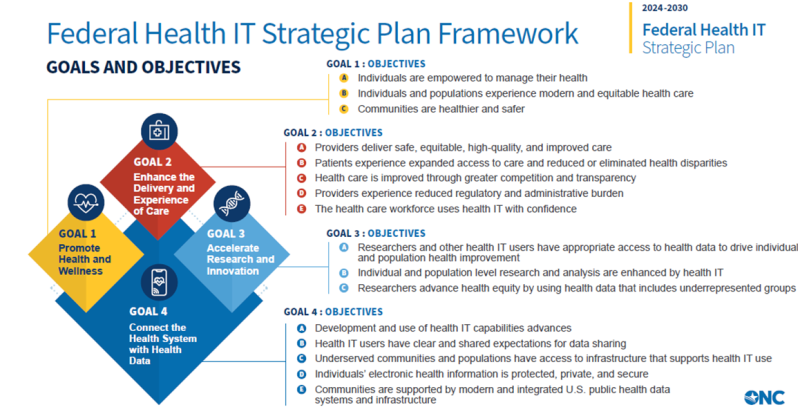Federal health IT officials unveiled a draft strategic plan outlining health technology priorities over the next five years focusing on health equity and artificial intelligence.
The draft plan (PDF) outlines federal health IT goals and objectives to improve health experiences and outcomes for individuals, populations, and communities, according to officials with the Office for the National Coordinator for Health Information Technology (ONC) within the Department of Health and Human Services. ONC also focused on how to use health IT to promote opportunities for improving health equity, advancing scientific discovery and innovation and modernizing the nation’s public health infrastructure, officials said.
The strategic plan is intended to serve as a road map for federal health IT initiatives and activities, and as a catalyst for activities in the private sector.
“As part of our statutory duty to align and coordinate health IT efforts with our federal partners, ONC collaborated on the draft Plan with more than 25 federal agencies. These agencies regulate, purchase, develop, and use health IT to deliver care and improve health outcomes, and they increasingly rely on the access, exchange, and use of EHI to effectively execute their missions,” said Micky Tripathi, Ph.D., national coordinator for health information technology.
In 2020, ONC released a five-year strategic plan that promoted a modern health IT infrastructure and drove significant progress across government and industry to advance the access, exchange and use of electronic health information (EHI), according to the agency.
The plan released last week seeks to build on that progress and includes an increased emphasis in areas such as public health and health equity. Given the excitement and skepticism about AI's growing use in healthcare, it's no surprise that ONC's multi-pronged, five-year strategy also focuses on AI.
"The draft plan acknowledges the swift evolution of AI and increased use in health care, emphasizing the urgent need for the federal government to navigate this transformative landscape both responsibly and effectively in health and health care," ONC officials wrote in a blog post.
The public can offer feedback and comments on the draft plan until May 28.
"The draft plan is deliberately outcomes-driven, with goals and objectives focused on improving access to EHI, delivering a better, more equitable health care experience, and modernizing our nation’s public health infrastructure," ONC officials Seth Pazinski, Peter Karras and Dustin Charles wrote in the blog post.
The plan zeroes in on four overall goals--health and wellness, enhance the delivery and experience of care, and
accelerate research and innovation and connect the health system with health data.
"The goals are divided into distinct categories, with goals 1 through 3 addressing plans to improve the experiences and outcomes for health IT users, while goal 4 is focused on the policies and technologies needed to support those users," they wrote.

The strategic plan also ties in with other HHS' priorities in the health tech space, including a new regulation that requires new technology upgrades while also advancing interoperability and transparency in predictive decision support tools. That final rule, called the Health Data, Technology, and Interoperability: Certification Program Updates, Algorithm Transparency, and Information Sharing (HTI-1), also established first-of-its-kind nationwide requirements for transparency around AI and algorithms used in health IT.
ONC says the strategic plan also aligns with HHS' strategy to bolster cybersecurity within the healthcare industry. Late last year, HHS released a healthcare cybersecurity concept paper and voluntary healthcare specific Cybersecurity Performance Goals (CPGs) to help health care organizations prioritize implementation of high-impact cybersecurity practices.
HHS’ concept paper outlined four major steps the department will take to advance healthcare cyber resiliency, including establishing voluntary cybersecurity goals for the healthcare sector, providing resources to incentivize and implement cybersecurity practices and implementing an HHS-wide strategy to support greater enforcement and accountability.
The American Hospital Association pushed back on HHS' efforts to push its "misguided concept paper, calls for mandatory cybersecurity requirements for hospitals alone."
"HHS’ repeated references to this concept paper demonstrates the logically flawed emphasis on hospitals as the primary source of cyber risk in health care. To make meaningful progress in the war on cybercrime, the federal government must be willing to take a strategic and holistic approach to this national security threat, not focusing on just one facet of the health care sector—hospitals. Any defensive strategy imposed on the health care sector must also be accompanied by an equally aggressive offensive cyber strategy by the government to counter the true source of cyber risk—foreign bad guys," John Riggi, AHA’s national advisor for cybersecurity and risk, wrote last week in response to the five-year draft strategic plan.
Other healthcare organizations voiced strong support for the draft plan.
"The Centers for Disease Control and Prevention (CDC) appreciates how the draft 2024-2030 Federal Health IT Strategic Plan addresses the need to continue to advance the nation’s public health data infrastructure, while making sure that it is benefiting the communities that need it most,' wrote Jim Jirjis, director of the CDC's Data Policy and Standards Division, in a statement.
“As the VA modernizes its electronic health record system, the draft 2024-2030 Federal Health IT Strategic Plan provides direction towards a seamless health care experience that helps patients and providers benefit from a connected health system,” said Meg Marshall, director of informatics regulatory affairs at the Veterans Health Administration. “Not only that, the draft Federal Health IT Strategic Plan serves as an actionable roadmap for the federal government to align and coordinate health IT efforts in a transparent and accountable manner. We are looking for public comment about ways to improve health through health IT, so that Veterans too can benefit from the goals of a coordinated federal health IT strategy.”